Ever found yourself Googling “how tall is the Eiffel Tower” and getting the exact answer right at the top of the page—no clicking required? You’re not alone. Those effortless little moments when Google (or any search engine) hands over the answer instantly are known as zero-click searches. And lately, they’ve been hogging the spotlight in the SEO world. So, what gives? Are zero-click searches a boon or a bane for your website? Let’s dive in.
A Glimpse Into the Zero-Click Phenomenon
Picture this: it’s a lazy Sunday morning in Kansas City, you’re brewing your coffee, and you want to know the weather for the day. You type “weather Kansas City” and—voilà—the forecast is right there. No need to load another page. That, in essence, is zero-click. A user’s search intent is fulfilled directly on the search engine results page (SERP), whether through:
- Featured snippets
- Knowledge panels
- Instant answers (unit conversions, facts)
- Local map packs
- “People Also Ask” boxes
You’ve likely done this hundreds of times yourself when using Google.
May be you were checking the cast of the horror movie ‘It’;
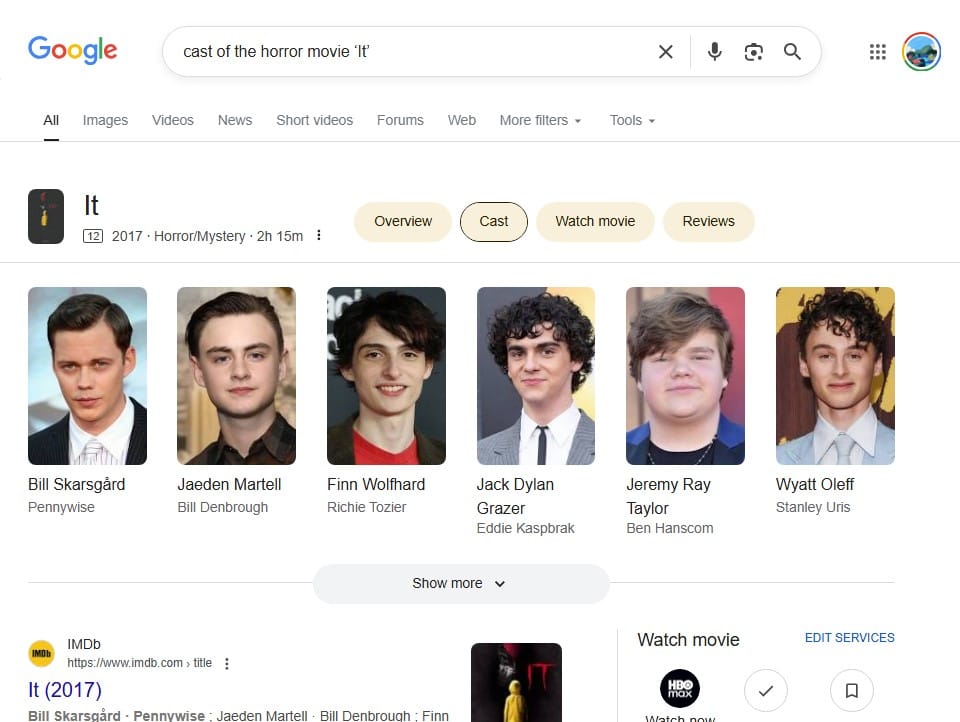
or you need a quick answer to how many ounces are in a gallon.

These are all classic examples of the zero-click phenomenon. It’s slick. It’s fast. And it’s creeping into more and more queries every day.
Understanding the Key Players: SERP Features That Drive Zero-Click Searches
So, you get the what and why of zero-click searches. But let’s get specific. What exactly are these “instant answers” you’re seeing on the search engine results page (SERP)?
These are called SERP features, and they’re the direct cause of the zero-click phenomenon. Each one is designed to give you information without needing to visit a website. Here are some of the most common features you’ll encounter:
AI Overviews
A new and increasingly common feature where Google’s AI synthesizes information from various web pages into a single, comprehensive answer at the very top of the SERP.
For the query “how to fix a leaky faucet,” you’d see a step-by-step summary generated by AI, including a list of tools needed and a brief explanation of the process—all without a single click.
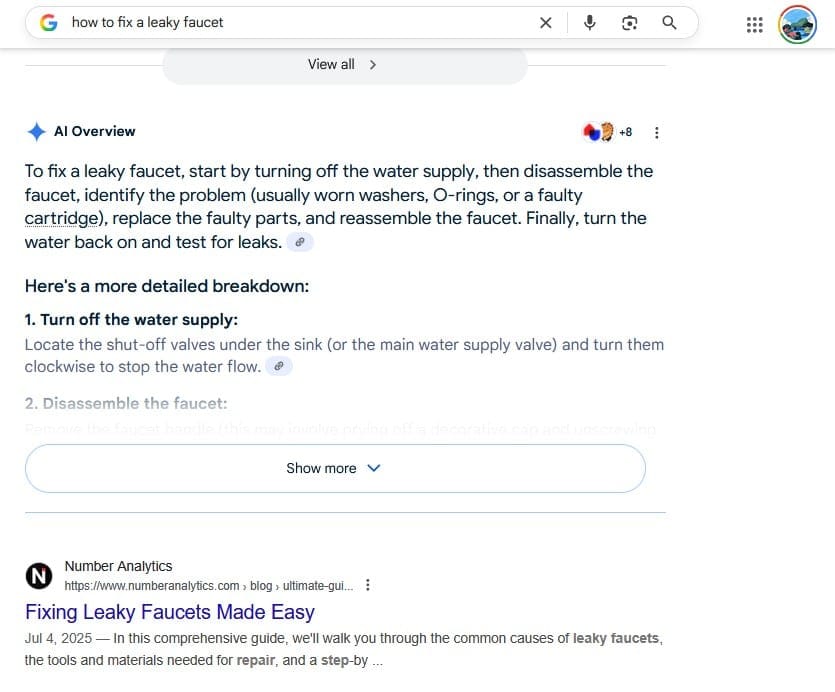
Featured Snippets
These are a user-friendly summary of an answer to a query, pulled directly from a high-ranking page. They’re often displayed in a prominent box and can take the form of a paragraph, a list, or a table.
When you search “why we tie a necktie,” a featured snippet appears; it’s a short paragraph answering your question, saving you from navigating to a site.
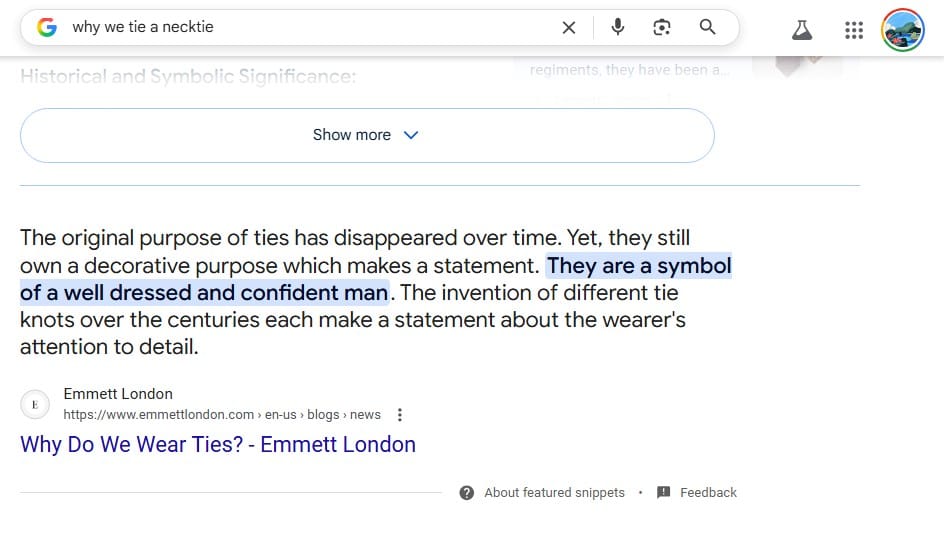
Direct Answer Box
This is the ultimate zero-click feature. For simple, factual queries, Google provides the answer directly in a box at the top of the page.
A search for “what is the boiling point of water?” will show a bolded number—212°F (100°C)—right at the top of the SERP, no questions asked.
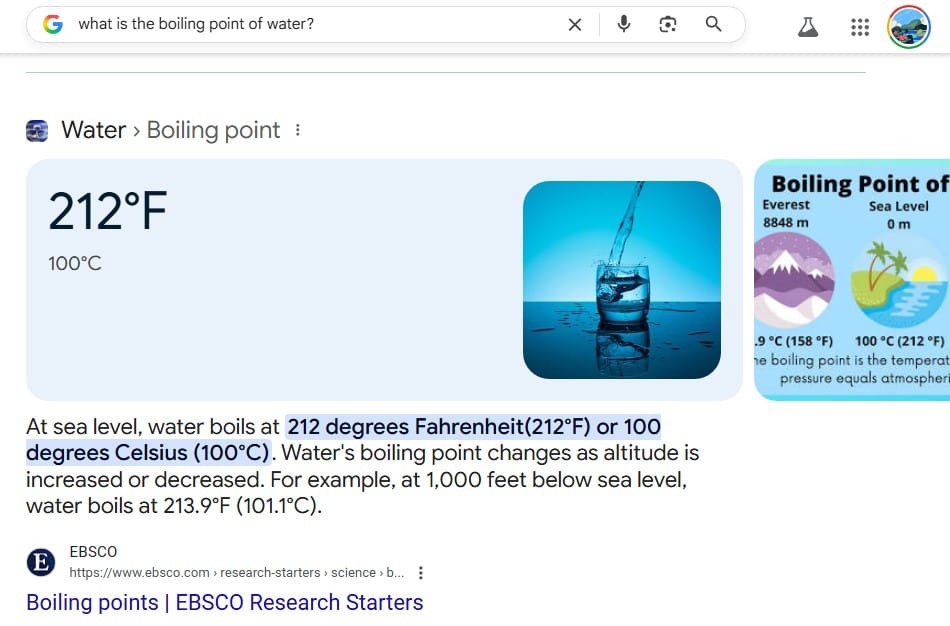
Knowledge Panel
For entities like people, places, or organizations, a knowledge panel provides a quick, structured overview. It’s a snapshot of key facts drawn from various sources.
Searching for the band The Beatles brings up a knowledge panel before the SERP, showing their members, top songs, awards, social accounts and formation date.
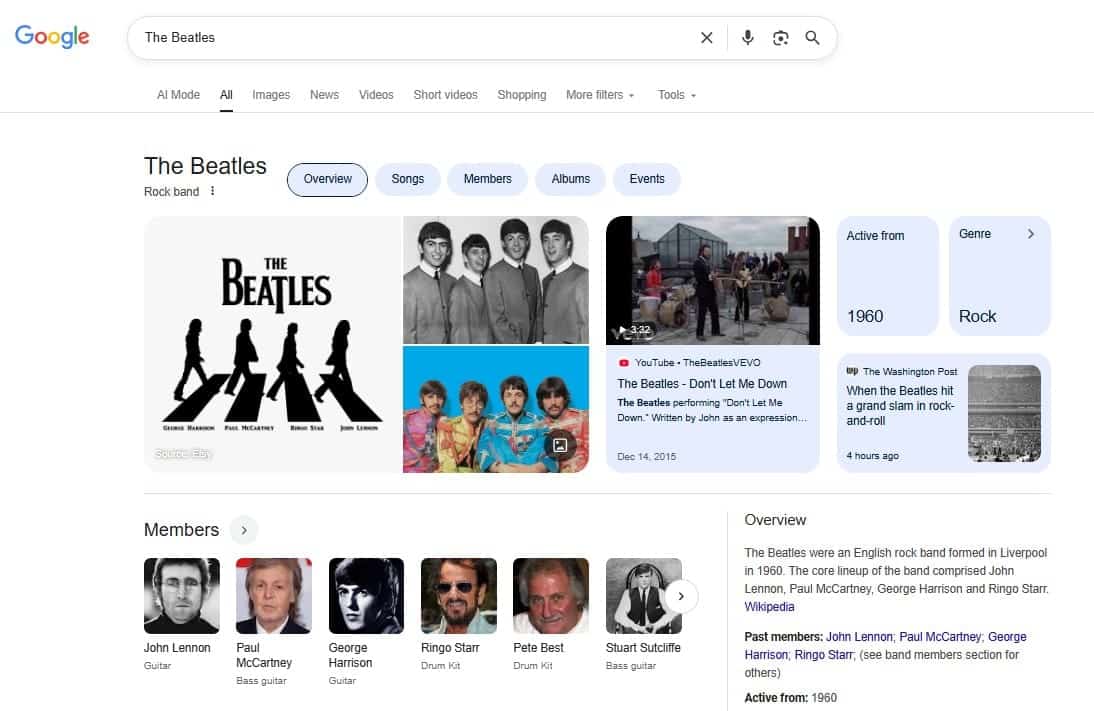
Local Pack
When you’re looking for a service or a business nearby, the local pack shows a map along with a list of relevant local businesses, complete with ratings, hours, and addresses.
The query “coffee shops downtown” triggers a local pack that displays a map with pins and a list of several coffee shops, allowing you to quickly compare ratings and hours before deciding where to go.
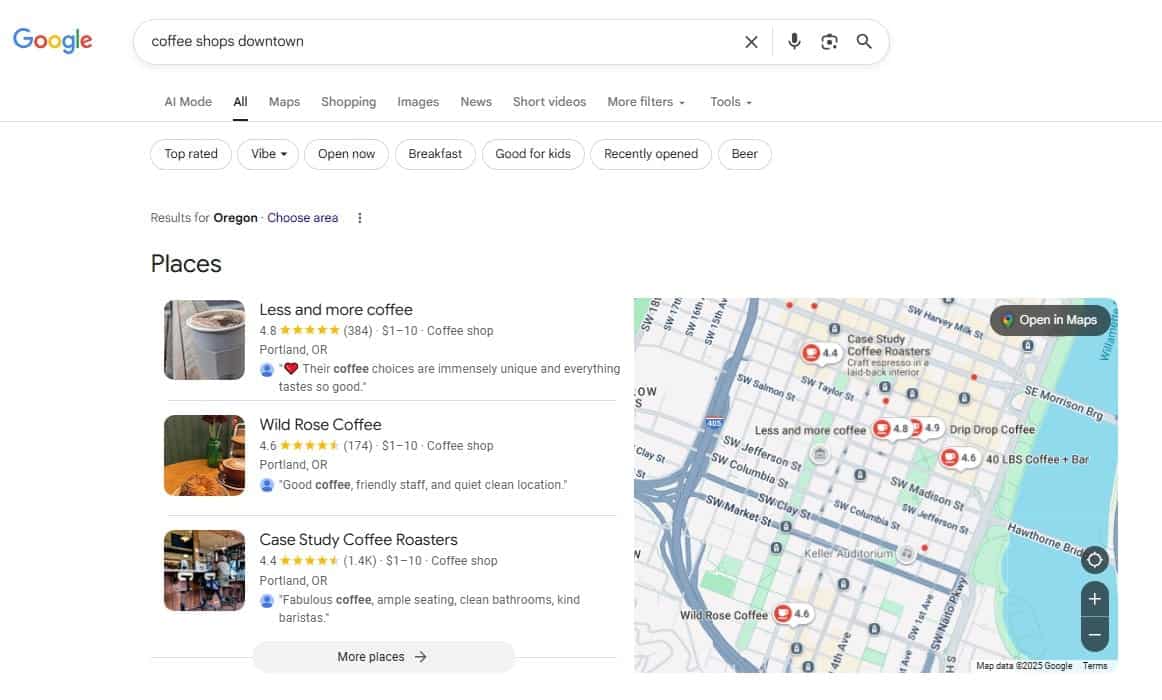
People Also Ask (PAA)
These are a series of related questions that expand when clicked, revealing a brief answer (often a featured snippet in disguise). They’re designed to help users explore a topic more deeply without having to run new searches.
After searching “why is the sky blue?” you might see a PAA section with questions like ” Why is the sky blue short answer?” or ” Why is the sunset red?”, each leading to a new instant answer.

Why Zero-Click Searches Are Exploding
We’ve come a long way since the bare-bones SERPs of the early 2000s. Google and its peers keep layering on new features, all aimed at satisfying our need for lightning-quick information. Here’s what’s driving the trend:
- AI-Powered Summaries
Google’s AI Overviews synthesize multiple web pages into a neat answer block. Think of it like someone summarized a dozen blog posts into one bite-sized nugget.
- Rich Snippets and Schema
Brands that mark up their content via schema.org often find Google plucking that content for instant answers. Think recipes with star ratings or event dates in the SERP.
- Voice Assistants
Siri, Alexa, Google Assistant—all powered by zero-click style results. You ask and they speak back the answer without linking to anything.
It’s not just hype. A SparkToro study found that 58.5% of searches on Google end without a click, with many users simply moving on after they get what they need. That’s a seismic shift from the days when every search was a gateway to a new website.
The Double-Edged Sword: Impact on SEO
Let’s be honest: zero-click searches can feel like a punch to the gut for content creators. After all, if your audience gets the info without ever visiting your site, where’s the traffic? But it’s not all doom and gloom.
- Reduced Click-Through, Sure
According to Semrush’s Zero-Click Study, approximately 25.6% of desktop searches and 17.3% of mobile searches result in a click. That’s markedly lower than just a few years ago, and if your bread-and-butter content lives behind clicks, you may see a dip in raw visitor numbers.
- Brand Visibility on Steroids
But here’s the flip side. When you secure a featured snippet or a knowledge panel, your brand becomes the authority in the blink of an eye. Even if users don’t click to your site, they see your name, your logo, your URL. That can seed trust and spark branded searches later on—especially in industries like travel or health, where authority matters.
- Shift in User Habits
Users have been rewarded for instant gratification, and they’re adapting. Brands need to recognize that capturing attention in the SERP itself can be just as valuable as coaxing someone to click through.
A Real-World Case Study: Ahrefs and Featured Snippets
Here’s a talking point you’ll appreciate: Ahrefs, a heavyweight in the SEO tools arena, has seen the percentage of search queries with featured snippets decline significantly since AI Overviews were introduced. According to a recent study, AI Overviews often supersede featured snippets because they serve a similar purpose of providing instant answers. This highlights the ongoing shift in the search landscape and reinforces the need for brands to adapt their strategies to target these new AI-driven features.
That’s proof-positive that zero-click isn’t necessarily traffic-negative; it just changes where and how you win.
Embracing Zero-Click: Strategies That Work
Okay, so you’re on board—but where to begin? Below are a handful of tactics that I’ve seen actually move the needle.
- Answer Questions Above the Fold
Don’t bury your answer five paragraphs down. Start with a short, sharp response to your target question—think one to two sentences—then expand below.
- Leverage Schema Markup
Recipe schema, FAQ schema, HowTo schema: these little tags signal to Google that you’re A-OK for instant-result placement.
- Craft Conversational Headings
Use H2s and H3s phrased as questions (e.g., “How Do Zero-Click Searches Affect Organic Traffic?”). Google will often pull those headings into the People Also Ask box.
- Balance Click and No-Click Goals
For “always zero-click” queries—like simple math or current time—consider focusing elsewhere. But for more complex queries, aim your efforts on securing both snippet placement and a compelling link snippet (e.g., add a benefit-oriented meta description).
- Build Your Brand in the SERP
Make sure your brand name appears in the answer block or snippet. That way, even if users don’t click, they remember who provided the info.
But Wait… Is This All Doom and Gloom?
Not by a long shot. I totally get that fewer clicks can feel like fewer wins. But I’d argue that if we’re in a golden age of ‘search as service,’ we need to rethink what victory looks like. It’s not just about referral numbers anymore. It’s about:
- Authority: Are you the source Google trusts to answer questions?
- Awareness: Does your brand stick in people’s minds when they see it in the SERP?
- Engagement Downstream: Do people who get answers come back later for deeper dives or to become customers?
Treat zero-click features as prime real estate rather than “lost” clicks. It’s a mindset shift, to be sure—but one that pays off.
The Road Ahead
Here’s where it gets really interesting: with AI integrations like ChatGPT and Google’s AI Overviews, the SERP is only going to get richer. Zero-click results won’t slow down; they’ll get smarter and more conversational. Brands that lean into clear, concise, and authoritative content now will find themselves ahead of the curve when the next wave of search features rolls in.
So, what are you waiting for? Begin auditing your keyword set, spot the queries that already trigger instant answers, and craft your content with both clicks and zero clicks in mind. And hey—if you land a featured snippet, celebrate. You’ve just claimed a piece of digital real estate in a world where attention is the currency.
Ready to reshape how you think about traffic? Leave a comment below with your biggest zero-click win or woe, and don’t forget to follow us on Facebook, X (Twitter), or LinkedIn for more hard-earned SEO insights.
Sources
- www.semrush.com/blog/zero-click-searches/
- www.neilpatel.com/blog/zero-click-searches/
- www.seo.com/blog/zero-click-searches/
- www.ahrefs.com/blog/featured-snippets/
- www.ahrefs.com/blog/how-serp-features-have-evolved-in-the-ai-era/



Understanding the Shift Towards Story-Driven Video Content in Digital Marketing
5 AI Shortcuts to Draft Your Q1 Content Outlines While You’re on Holiday